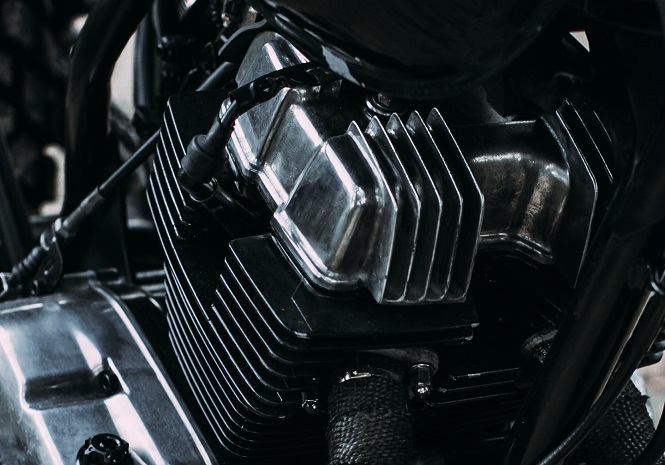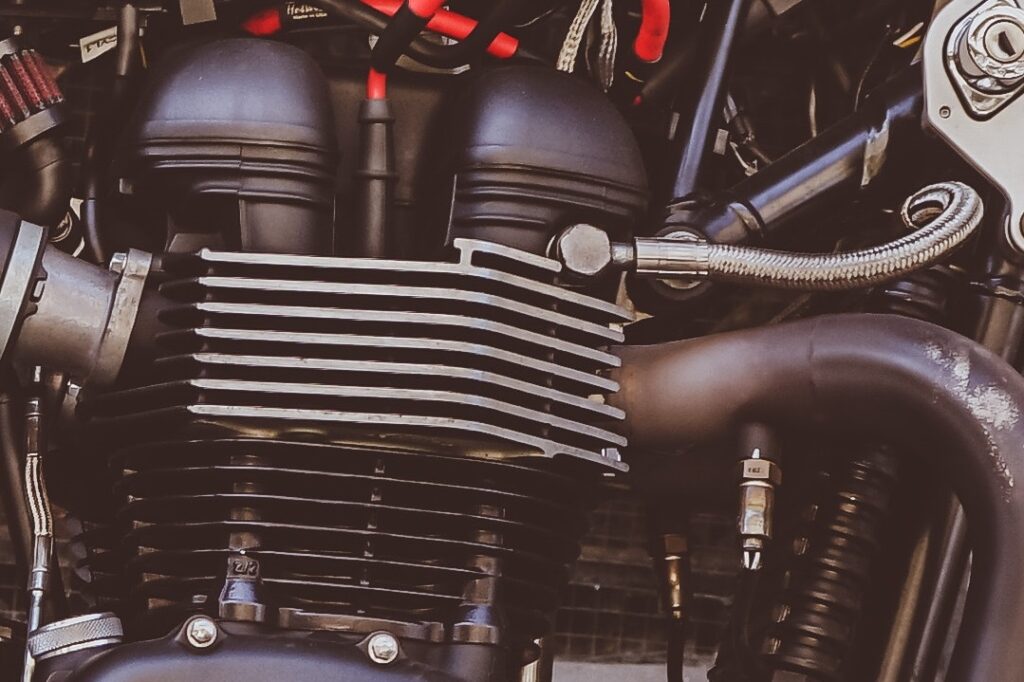Engine fins in motorcycles help in heat dissipation of the engine through air circulation over its elongated surface area.
Dirt and grease accumulation on the fins will result in engine overheating since fins are not dissipating heat properly. You need to clean the dirt from the fins.
So, how to clean motorcycle engine fins? The main steps involved in engine fins cleaning include:
- Allowing the engine to cool down
- Prepare the cleaning mixture
- Spray high pressure water on fins
- Use brush to clean the dirt
- Water cleaning at last to wrap up
Before diving into each of these steps in detail, let’s first look into why fins need cleaning and what are the prerequisites.
Why do engine fins need cleaning?
As the course of motorcycles advanced, many new cooling systems such as liquid-cooled, oil-cooled systems were introduced. Even after the invention of such efficient cooling systems, the motorcycle fins or the air cooled systems are still popular, especially in many low budget motorcycles.
Engine fins are made of aluminum. The engine itself will be either made of cast iron or aluminum alloys. For more details, here is our explainer on materials used for an engine block.
Due to the fins exposure to external weather and mechanical fluid, dirt builds on it over time.
There are mainly two instances in which the engine fins need cleaning.
- For restoration of old motorcycles: when your motorcycle gets old gradually, rusting becomes a common issue in your motorcycle. That may cause some irregularities in your engine which results in fading. As a result, the engine’s functioning may slow down.
- To prevent the motorcycles from overheating: after a few years of proper functioning, you may notice that your motorcycle engine gets overheated very frequently. That usually happens when your motorcycle fins get dirty due to some dust particles entering the engine and hence, not disspating heat faster.
Engine fins take a long time to get dirty. However, once the dirt and grease accumulate, this dirt accumulation makes them less effective as the passage of air starts to get blocked out and if the dirt accumulated is a grease base then it attracts more dust particles from the surroundings if not cleaned at the earliest. The cleaning of fins increases both the engine shell and the engine life as well.
What should you know before cleaning fins?

Cleaning fins is easier said than done. The process involved in the cleaning is very simple. But there are some important tips one should know before heading up towards their motorcycles.
- Opening the engine cover: Cleaning the fins while on motorcycle is good but taking them apart and doing so is better. This process of opening the fins will require some prior knowledge about the engine parts and functions. This way of cleaning may require more labour but it produces fabulous results. In this way we are able to wash every corner of our fins with ease.
- Type of brush: The type of brush will significantly affect the end result of the cleaning. Brushes with more and longer bristles are very good due to their reach in congested spaces. Wire brushes are good but they leave behind scratches. So soft brushes should be preferred.
- Dremel Sanding bits: These sanding bits are great for those people who want to enhance the look. These sanding bits are quite big to fit between fins but it works perfectly for its edges. It’s not essential for cleaning but instead depends on personal preference.
- Sandpaper: Sandpaper is very thin and has a very rough texture. This thin nature helps it to easily slip between the fins and it’s rough texture helps to cut the dirt and sweep them out easily. Wrapping the sandpaper around a flat edged metal file will increase its efficiency.
Equipment and materials required
- Brush: When it comes to cleaning brushes there is a large variety of them out there. But in such a case where a motorcycle is washed on a daily basis the dirt collected should easily be dealt with with the help of a soft brush. The brush used should have bristles. Such brushes are prefereable since they don’t leave scratch marks.
- Degreaser: Degreasers are very good for removing light to moderate dirt particles. It can be made at home by mixing 1 cup of distilled white vinegar, 1/4 cup soap, 1 tablespoon of baking soda, and a couple drops of lemon juice/essential oils. Combine all of these in a bowl and add water.
- Buffing Polish: This is an optional item as it will help in making the fins look shiny as new.
How to clean engine fins?

There are a lot of different ways of cleaning engine fins. But each one of them corresponds to the condition in which the fins are in.
The condition of fins could be known by doing an external examination and reviewing the cleaning cycle it has had to date. Even after so many exceptions, the base cleaning of fins is the same. Several techniques are to be followed for cleaning engine fins.
#1: Allow the engine to cool down
Even after having fins, the engine gets heated up. This heat lowered by fins is beneficial for the engine but the heat left behind is still harsh for our skin.
Cleaning a motorcycle directly after driving can result in burns and injuries. So the best way of avoiding it is to allow the motorcycle to cool down before you start working on it.
#2: Prepare the cleaning mixture
The type of dirt built up on the motorcycle fins depends on its maintenance cycle. The dirt can vary from light to heavy. To cut through such dirt we need to formulate our own suitable cleaning mixture.
This mixture must have lukewarm water, grease-cutting dish soap, or liquid. You can also add vinegar, baking soda, and a few drops of lemon to enhance the degreasing abilities.
#3: Spray high pressure water on fins
The first step of cleaning should start with spraying water on the fins. The water pressure should be as high as possible.
The high water pressure will help the water to cut through thick layers of dirt and make them loose. But care should be taken during this process. You need to avoid spraying into electrical wiring, air boxes, air filter, and other parts that are prone to water damage.
#4: Brushing
Brushing is the main step in cleaning engine fins. Once you have sprayed water to loosen up the dirt and removed a few dirt layers, it’s time to brush and clean the remaining dirt and grease on the fins.
Brushing should always be done layer by layer, starting from the top fin and moving downwards. The brushing should be done with gentle strokes.
The brush has to be cleaned with water as soon as one layer is cleaned, to avoid dirt from sticking on the next layer. Dip the brush in the cleaning fixture for each layer of cleaning.
#5: Water cleaning to wrap up
Once you have brushed the dirt away from all the fin layers, there is only one last step remaining. Spray the high-pressure water using jets to clean the fins.
That should be more than sufficient for a thorough engine fins cleaning. If you are interested in more aesthetics, you can use a buffing polish to polish the fins.
Related Questions
Why is it important to clean engine fins?
To keep the engine running for longer periods, the heat from the engine should dissipate properly, and clogged fins prevent this from happening. So engine fins should be cleaned regularly for easier heat dissipation from the engine.
Are radiator fins and engine fins the same?
Radiator fins and engine fins are not the same.
The working process of both the fins is similar. Both the fins are used to direct the wind. But the placements of both these fins are different. Radiator fins are placed in front of the radiator and engine fins are embedded in the engine shell.
How to remove oxidation from engine fins?
To remove oxidation from fins or any part of the engine, the required ingredients are acid and baking soda. Start cleaning the engine with acid and then finish off by spraying a mixture of baking soda and water.
What parts should I cover before cleaning?
Before cleaning the engine fins, you should try to cover every sensitive/ non-water resistant part. Parts such as the battery, ignition wires, engine control unit, and all the other electrical components need to be protected.
How to remove white corrosion from the aluminum engine?
White or any kind of corrosion can be removed by combining distilled water with pure lemon juice or vinegar and then gently rubbing the mixture over the affected area on the fin or engine surface.
